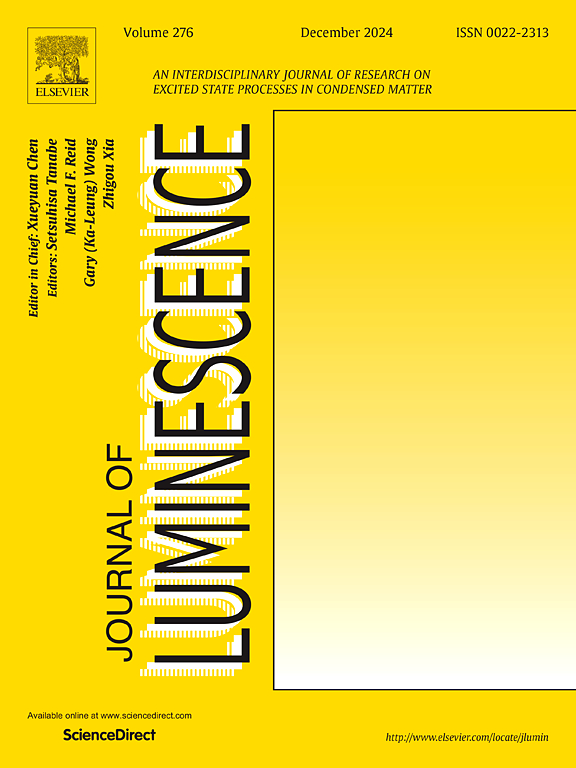Ultraviolet afterglow of undoped MgAl2O4 derived via solution combustion
IF 3.6
3区 物理与天体物理
Q2 OPTICS
引用次数: 0
Abstract
Combining experiments to density functional calculations, photoluminescence (PL) and afterglow properties of solution-combustion derived MgAl2O4 were investigated. Under the 255 nm photoexcitation, the PL spectrum of undoped MgAl2O4 exhibits two ultraviolet subbands peaking at 3.41 eV (363.6 nm) and 3.18 eV (389.9 nm), respectively. After the irradiation of a high-pressure mercury lamp is terminated, undoped MgAl2O4 exhibits ultraviolet afterglow that lasts for about 20.5 min. The afterglow spectrum of undoped MgAl2O4 consists of dual ultraviolet subbands peaking at about 360 and 390 nm, correspondingly. Within the scheme of meta generalized gradient approximation, defect energy levels of oxygen vacancies (F0, F+, F2+), aluminum vacancy and magnesium vacancy are determined numerically via density functional calculations. In terms of the defect energy levels of oxygen and aluminum vacancies, optical transitions arising from these defects are constructed for undoped MgAl2O4, both the dual-subband PL and the dual-subband afterglow can be interpreted. The ultraviolet afterglow with dual subbands validates our hypothesis of the oxygen and cation vacancies in host acting as the origins of the afterglow of undoped MgAl2O4. Apart from opening a window for exploring the afterglow mechanisms of rare-earth doped MgAl2O4, the validity of the hypothesis unlocks the power of harnessing intrinsic defects as luminescence center of afterglow to develop novel afterglow materials.
溶液燃烧制备未掺杂MgAl2O4的紫外余辉
结合实验和密度泛函计算,研究了溶液燃烧衍生MgAl2O4的光致发光和余辉特性。在255 nm光激发下,未掺杂MgAl2O4的PL光谱呈现出两个紫外亚带,分别在3.41 eV (363.6 nm)和3.18 eV (389.9 nm)处达到峰值。高压汞灯照射结束后,未掺杂的MgAl2O4呈现出持续约20.5 min的紫外余辉。未掺杂的MgAl2O4的余辉光谱由双紫外子带组成,分别在360 nm和390 nm处达到峰值。在元广义梯度近似方案下,通过密度泛函计算确定了氧空位(F0, F+, F2+)、铝空位和镁空位的缺陷能级。根据氧和铝空位的缺陷能级,对未掺杂的MgAl2O4构建了由这些缺陷引起的光学跃迁,可以解释双子带PL和双子带余辉。具有双亚带的紫外余辉验证了我们的假设,即宿主体内的氧和阳离子空位是未掺杂MgAl2O4余辉的来源。该假设的成立不仅为探索稀土掺杂MgAl2O4的余辉机制打开了一扇窗,而且开启了利用内在缺陷作为余辉发光中心来开发新型余辉材料的力量。
本文章由计算机程序翻译,如有差异,请以英文原文为准。
求助全文
约1分钟内获得全文
求助全文
来源期刊

Journal of Luminescence
物理-光学
CiteScore
6.70
自引率
13.90%
发文量
850
审稿时长
3.8 months
期刊介绍:
The purpose of the Journal of Luminescence is to provide a means of communication between scientists in different disciplines who share a common interest in the electronic excited states of molecular, ionic and covalent systems, whether crystalline, amorphous, or liquid.
We invite original papers and reviews on such subjects as: exciton and polariton dynamics, dynamics of localized excited states, energy and charge transport in ordered and disordered systems, radiative and non-radiative recombination, relaxation processes, vibronic interactions in electronic excited states, photochemistry in condensed systems, excited state resonance, double resonance, spin dynamics, selective excitation spectroscopy, hole burning, coherent processes in excited states, (e.g. coherent optical transients, photon echoes, transient gratings), multiphoton processes, optical bistability, photochromism, and new techniques for the study of excited states. This list is not intended to be exhaustive. Papers in the traditional areas of optical spectroscopy (absorption, MCD, luminescence, Raman scattering) are welcome. Papers on applications (phosphors, scintillators, electro- and cathodo-luminescence, radiography, bioimaging, solar energy, energy conversion, etc.) are also welcome if they present results of scientific, rather than only technological interest. However, papers containing purely theoretical results, not related to phenomena in the excited states, as well as papers using luminescence spectroscopy to perform routine analytical chemistry or biochemistry procedures, are outside the scope of the journal. Some exceptions will be possible at the discretion of the editors.
 求助内容:
求助内容: 应助结果提醒方式:
应助结果提醒方式:


